Have you ever wondered if a plant can survive without sunlight?
Of course, no plant can survive without any light at all. But it might surprise you to learn that there are definitely plants that don’t need sun to grow. This can be great news for anyone struggling to find enough sunlight to grow houseplants indoors, especially when you see just how many plants that grow without sunlight there are if all of their growing needs are met.
If your indoor space doesn’t get a lot of natural sunlight but you want to grow living greenery, indoor plants that don’t need sun are the right choice. They are hardy and easy to take care of, and many are common, beloved, and long-living houseplants.
In particular, many tropical plants adapt well to low-light indoor conditions because their native habitats are low-light areas under forest canopies where there is little direct sunlight and lots of shade.
Keep reading to see just how you can decorate that low-light room you’ve been struggling with!
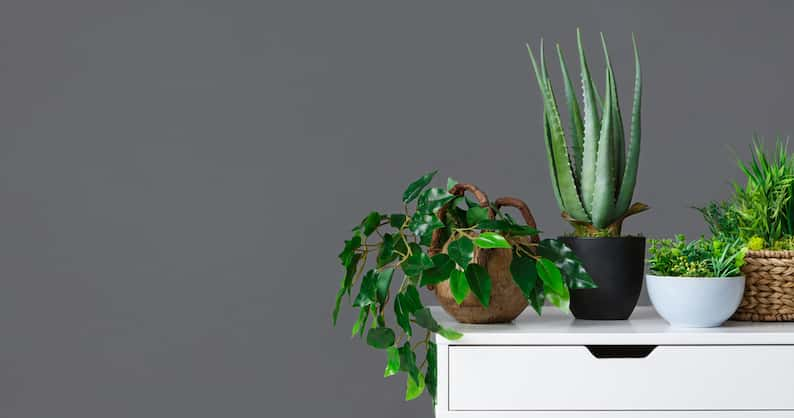
Table of Contents
Plants that can survive without sunlight
Plants that grow in low-light conditions are different from plants that need direct sunlight or high light conditions. When growing indoor plants that don’t need sunlight, there are a few things to consider:
- With plants that can grow without sunlight, avoid overwatering as you don’t want to develop root rot without the extra light that can often help to reduce the risk of this happening. The plants will suffer and eventually die if left to sit with waterlogged roots. Using a moisture meter ensures you will know how much moisture is retained in the pot and can avoid overwatering.
- Similarly, be careful with accidentally over-fertilizing your plant. When growing plants that can grow without sunlight, this can lead to your plant being stressed with too much fertilizer, so you should only use a weak fertilizer solution during their active growing seasons.
- Cleaning dust from plant leaves regularly will help plants with photosynthesis, as the dust can block the little light they are exposed to and interferes with proper growth. Gently wipe leaves with a damp cloth to remove built-up dust.
- Make sure you’re not accidentally exposing your plants to too much light. The plants on this list are particularly susceptible to this, so knowing the signs and taking action quickly if you notice any is critical.
1. Snake Plant (Dracaena trifasciata)
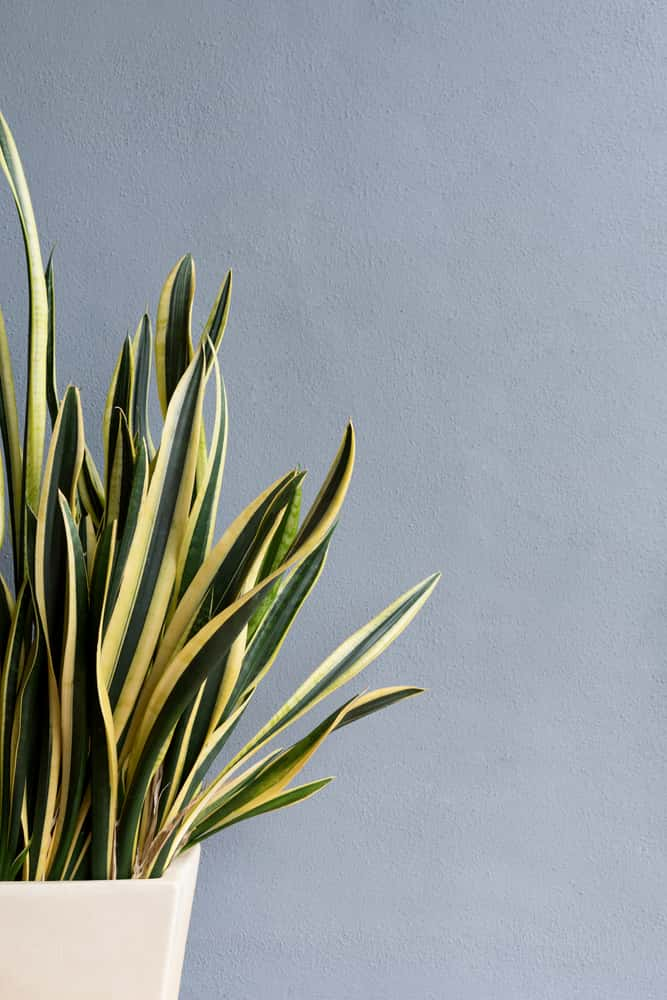
Snake plant, also called mother-in-law’s tongue or, for its botanical name, Dracaena trifasciata, is a very hardy plant that tolerates low moisture and low light very well. The leaves are glossy, leathery green, but some may have a yellow or white border. It is a succulent plant native to tropical West Africa, with stiff, sword-shaped leaves from six inches to eight feet tall.
It has a reputation of being almost impossible to kill, although overwatering and root rot can do the job by harming and possibly killing it. The snake plant can go up to two months between watering in winter, and only needs water every three to four weeks in spring and summer. Being a tropical plant, the snake plant prefers warm conditions and will suffer in colder than 50 degree temperatures.
2. Bromeliad (Bromeliaceae genera)
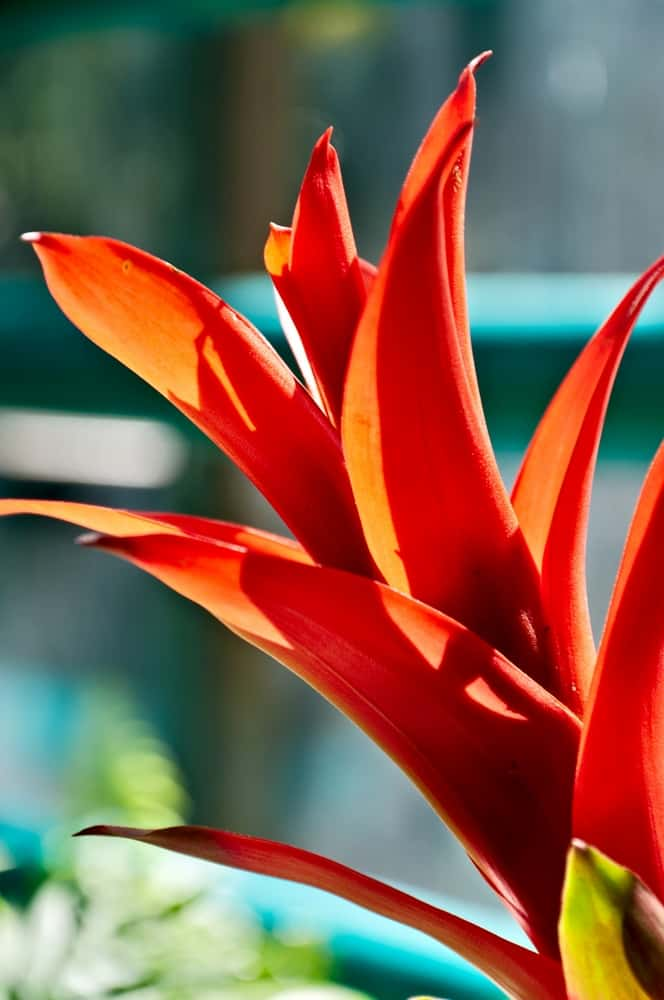
Bromeliad, or Bromeliaceae genera, is native to the tropical and subtropical Americas, and is a perennial that includes both epiphytes and terrestrial species. They are slow growing plants that take up to three years to reach blooming maturity. They need only filtered light and loose soil, so generally potting soil mixed with sand is best.
Bromeliads are unique looking plants, with long leaves growing from a central base in an outward fountain formation and the blooming flower growing from the center. The plants can be watered in the center cup or rosette of leaves. Water sparingly and don’t let the plant get too cold or sit in cold conditions for any length of time.
3. Calathea (Calathea lancifolia)
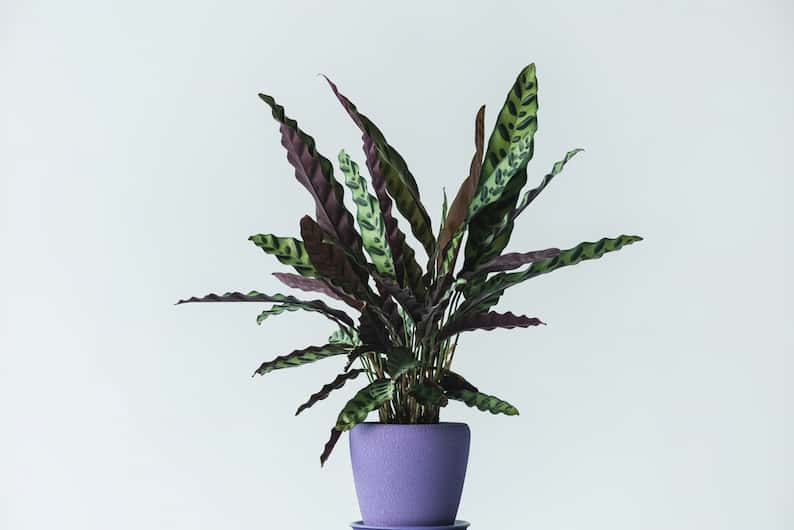
Calathea, or Calathea lancifolia, is also known as the rattlesnake plant and has unusual pink or white striped oval leaves. It’s native to tropical Brazil and likes warm temperatures and high humidity, suffering in the cold. Calathea is one of the best small plants that don’t need sunlight, preferring low light environments and so is perfect for a room that has no windows or no direct sunlight at all.
Unlike some other tropical plants that tolerate drought conditions, the rattlesnake plant does not do well in low moisture, so keep the soil evenly moist but never waterlogged. Water at least weekly, if not every few days, and never let the soil dry out completely so leaves wilt. Keep Calathea in a warm space between 70 and 85 degrees for best growth.
4. Peace Lily (Spathiphyllum wallisii)
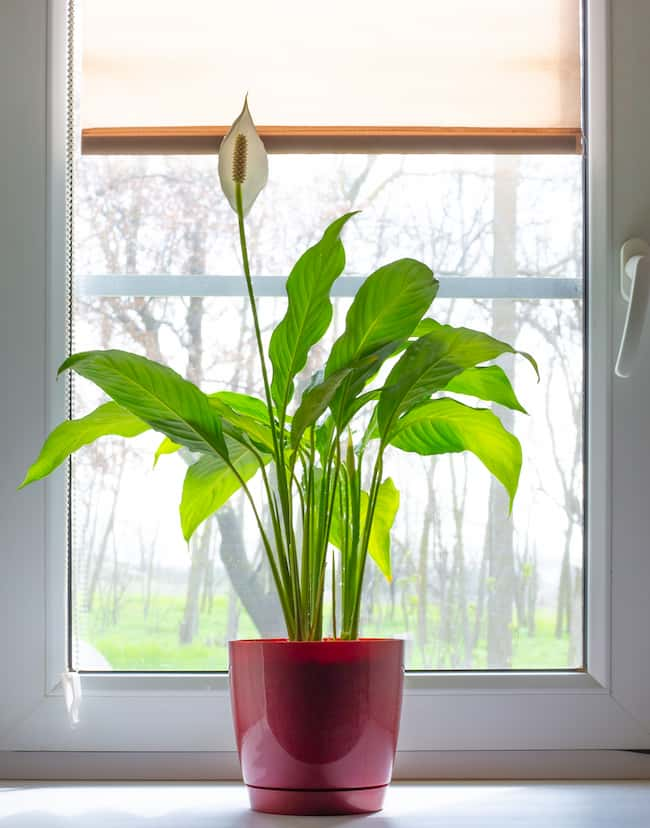
The peace lily, or Spathiphyllum wallisii for its botanical name, is a beloved flowering houseplant with glossy oval leaves and a white hooded flower that grows from the center of the plant. It’s native to South America, and is toxic to animals and humans, so it may not be a good plant in a house with pets or babies. although could do well in an office for anyone looking for small desk plants that don’t need sunlight. They are shade-loving plants in their native habitats, and will burn in direct sunlight.
Their native habitat is in the tropical forest understory in leaf litter, so they don’t need much light although do prefer having loose soil with a lot of organic matter. They do not like to be overwatered, so make sure their container has good drainage and only water when the top inch of soil is dry. They like high humidity in summer and temperatures not lower than 55 degrees.
5. Golden Pothos (Epipremnum aureum)
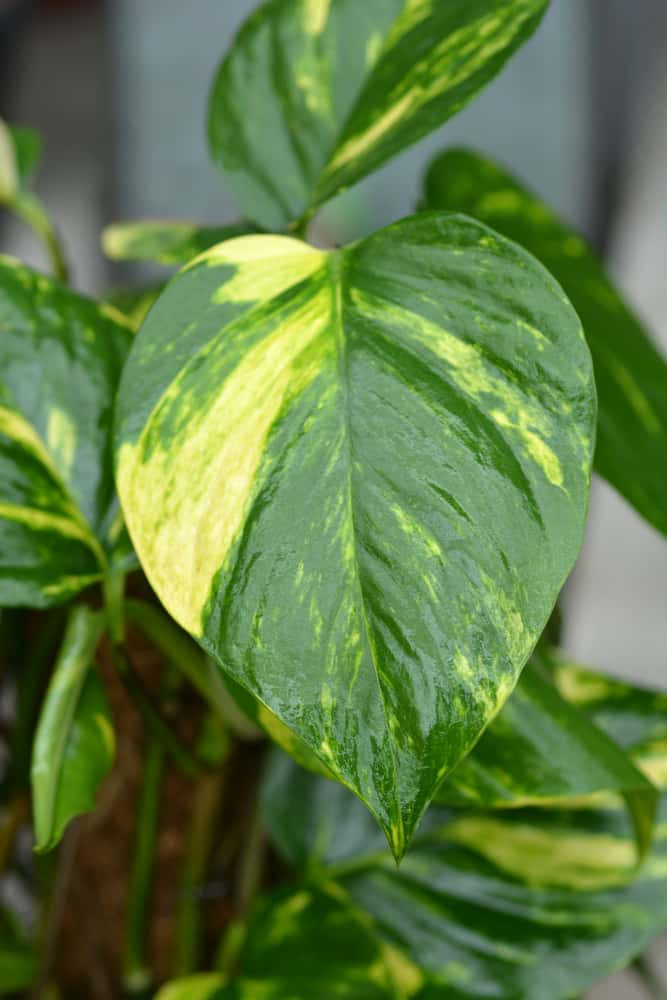
The golden pothos, Epipremnum aureum, also called devil’s ivy or devil’s vine, is a tropical low light vining plant with pretty heart-shaped leaves. It’s native to the South Pacific, and is very easy to grow, doing perfectly fine without direct sunlight in low light conditions. To add to its simplicity, it even tolerates drought conditions (but not totally drying out and wilting), although is toxic to pets, so beware to keep it out of reach of animals.
The pretty leaves can be variegated with white, yellow, or pale green striping, and vines can grow very long in favorable growing conditions. It does not flower, and likes moist, well-drained soil that dries out between watering. The vigorous vining nature of pothos makes it a nice plant for hanging baskets (in fact, this is exactly why this is one of my top picks for the best low light hanging plants you can add to your home) or to train on a trellis.
6. Dragon Tree (Dracaena marginata)
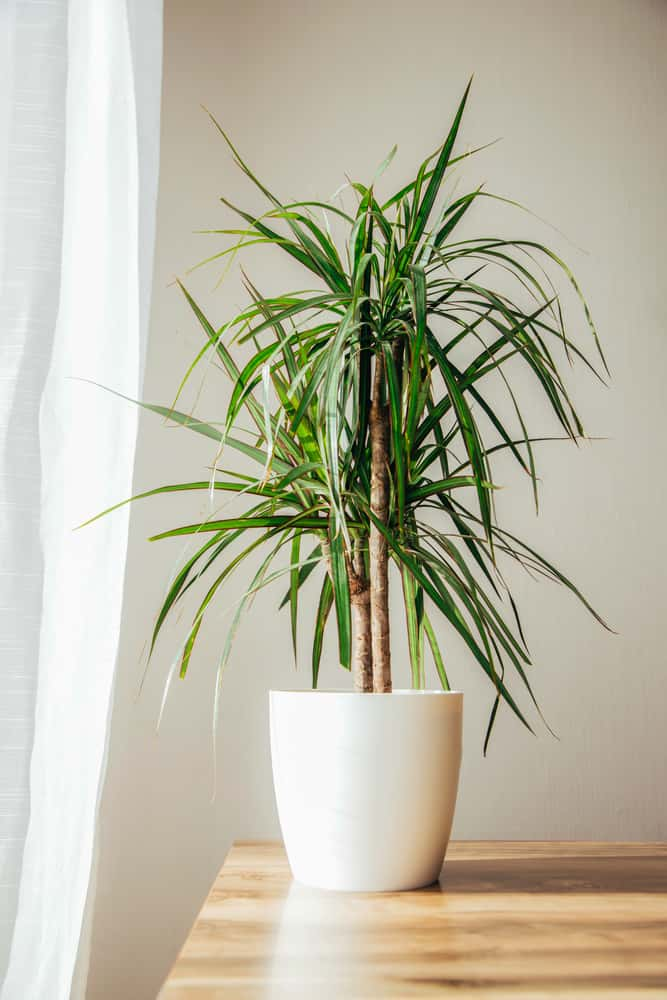
The dragon tree, Dracaena marginata, is an attractive plant growing from a central woody stalk with branches sprouting spiky red-edged leaves. It’s a striking plant for any indoor space, growing up to six feet in favorable growing conditions. It’s a broadleaf evergreen native to Madagascar that grows slowly and is toxic to dogs and cats.
The Dragon tree tolerates a wide range of indoor temperatures and is not overly sensitive to differences in warmth and cold. It likes bright indirect light but tolerates partial shade, growing more slowly in lower light conditions, so it definitely meets the criteria of plants that can survive without sunlight. For these same reasons, it’s also a great indoor tree for low light conditions.
It’s drought tolerant and does not like to be overwatered, so let the top half of the soil dry before watering, generally every three weeks or so.
7. Chinese Evergreen (Aglaonema communtatum)
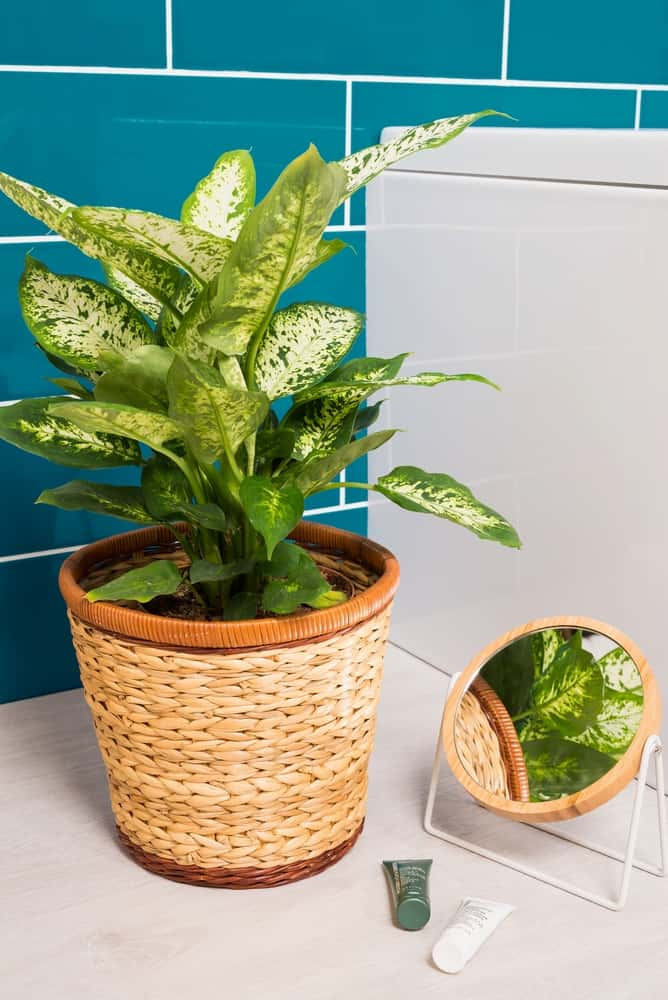
Chinese evergreen or Philippine evergreen, Aglaonema communtatum, is a native of Asia, with large glossy oval leaves with color variations from dark green to silver to red. It grows in partial to full shade and so is tolerant of low light indoor conditions. It is toxic to dogs and cats, and likes to dry out between watering.
The Chinese evergreen likes humidity and warmth, so keep it away from air conditioning vents or open windows and mist it frequently or keep a humidifier nearby. As mentioned, while it doesn’t like direct sunlight, it does need to be kept warm enough for its liking so keep it in temperatures of at least 65 degrees or warmer. The lighter colored the leaves are, the more light they will need, so keep that in mind if you have a sliver or light green plant.
8. Staghorn Fern (Platycerium bifurcatum)

Staghorn fern, Platycerium bifurcatum, is an epiphytic fern native to Asia and Australia. As an epiphyte, Staghorn fern doesn’t grow in soil, it grows on tree branches in its native habitat. As houseplants, Staghorn ferns are grown on plaques or sections of tree bark and make striking focus plants for any setting.
Staghorn ferns have unusual green antler-shaped leaves growing out of the root ball covered with smaller flat leaves. The plant can be three to six feet around, in shaded light with warmth and humidity, so it needs sturdy support. Water the root ball about once a week but let it dry out in between watering, and mist the plant well.
9. Moth Orchid (Phalaenopsis spp.)
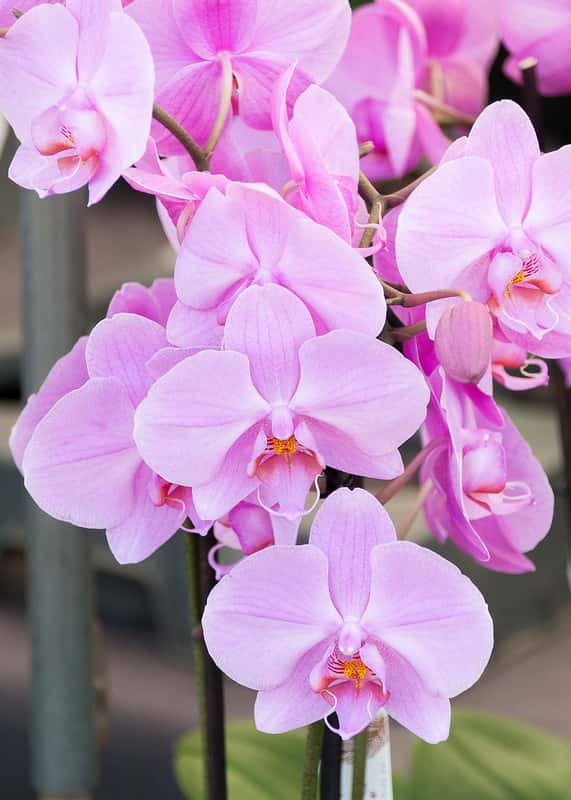
Moth orchid, Phalaenopsis spp., is an herbaceous perennial flowering plant with thick leathery green leaves and arching sprays of delicate flowers. Flowers are born on a single flower spike that can have up to 20 flowers. It is native to southeastern Asia and parts of Australia with 70 species.
The Moth orchid is epiphytic, meaning it grows up in the tree canopy in its native habitats and so doesn’t need soil. Instead, they’re usually fine to be just rooted in wood chips or other loose material. They need regular moisture and fertilizer during active growing periods. They will scorch in direct sunlight and must have low light only, making them perfect for anyone looking for indoor plants that don’t need sunlight.
10. Philodendron (Philodendron spp.)
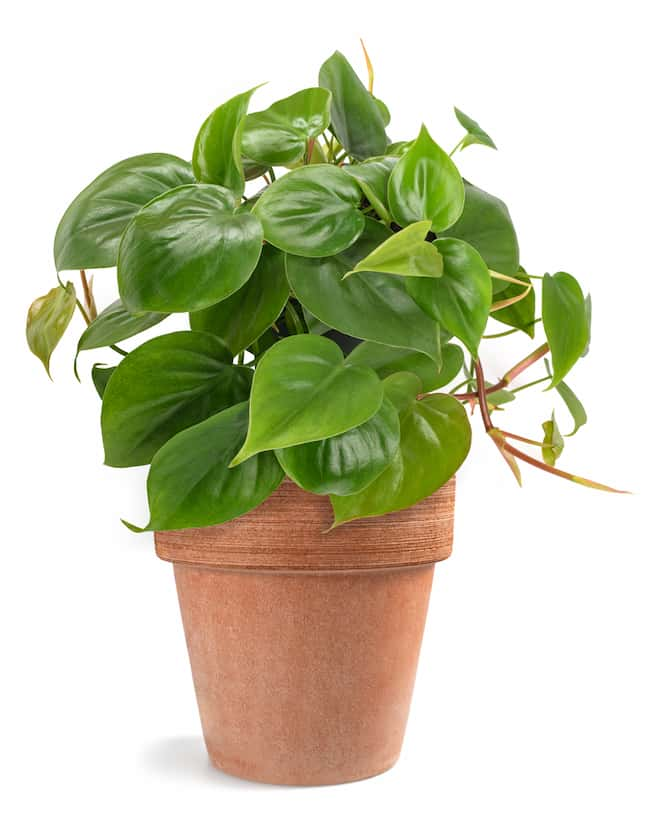
Philodendron, Philodendron spp. is in the Araceae family with hundreds of species, both vining and non-climbing. They are toxic to animals and humans if ingested, so care should be taken around pets and children. Philodendrons are tropical perennial plants native to Central and South America, with glossy green leaves and fast growth habits and upright or vining plants.
Your philodendron will need loamy, well-drained soil and will also prefer bright indirect light, as direct sunlight will burn their leaves. These plants are sensitive to moisture levels, wilting with overwatering and overly dry conditions alike, so using a moisture meter is the best way to care for philodendrons. Don’t waterlog roots and don’t let the soil dry out completely.
11. ZZ Plant (Zamioculcas zamiifolia)

The ZZ plant, Zamioculcas zamifolia, is a pretty green plant with a unique appearance. It has waxy green oval leaves that grow on long curving stems and is a tropical perennial native to Eastern Africa that’s mildly toxic to humans and animals. ZZ plant is slow growing and easy to care for, being drought tolerant and needing to be watered only every couple of weeks.
ZZ plant grows from rhizomes that store water under the soil and grow well in low light. The soil can dry out completely between watering, and should not be waterlogged at any point. It is very low maintenance, needing only to stay out of drafts and in temperatures warmer than 50 degrees.
12. Peperomia (Peperomia spp.)
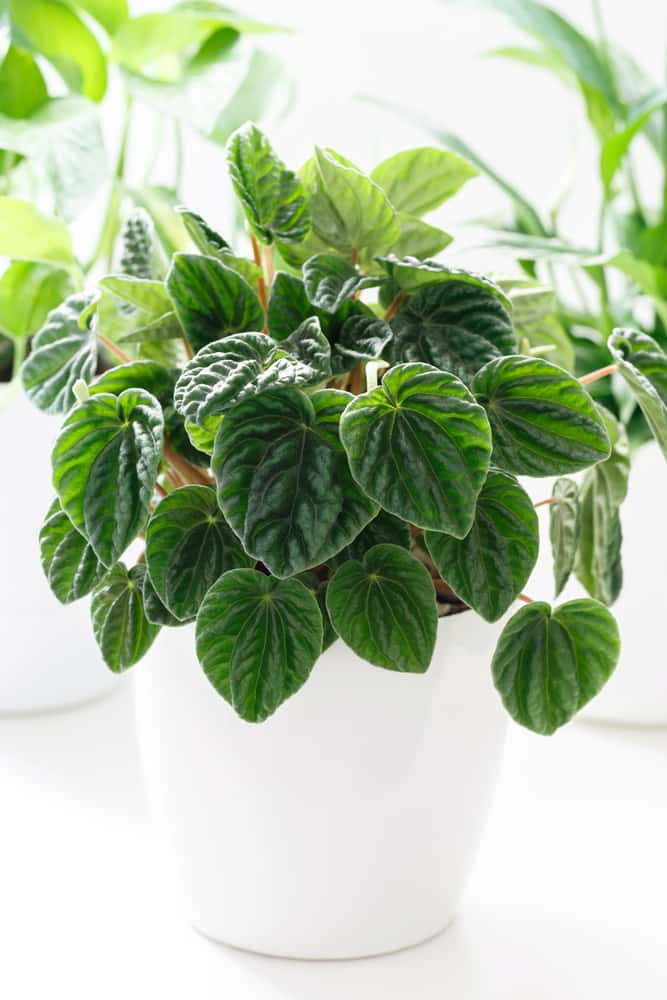
Peperomia plant, Peperomia spp., is a tropical perennial plant in the Piperaceae family with more than 1,000 species, native to the Caribbean, South America, and Mexico. Different types have pretty heart-shaped or oval leaves in green, red, gray, or purple, or variegated, marbled, or solid green. All peperomia species are low-maintenance and slow growing, and are great as small desk plants that don’t need sunlight.
As epiphytes, peperomia plants don’t need soil; like orchids, they grow in shredded bark or other loose soilless medium like peat or porous stone. They rarely need fertilizer and only need water when dry. While they don’t need direct sunlight, they don’t do well in very low light conditions and need at least 12 hours of medium to bright light.
13. Dumb Cane (Diffenbachia spp.)
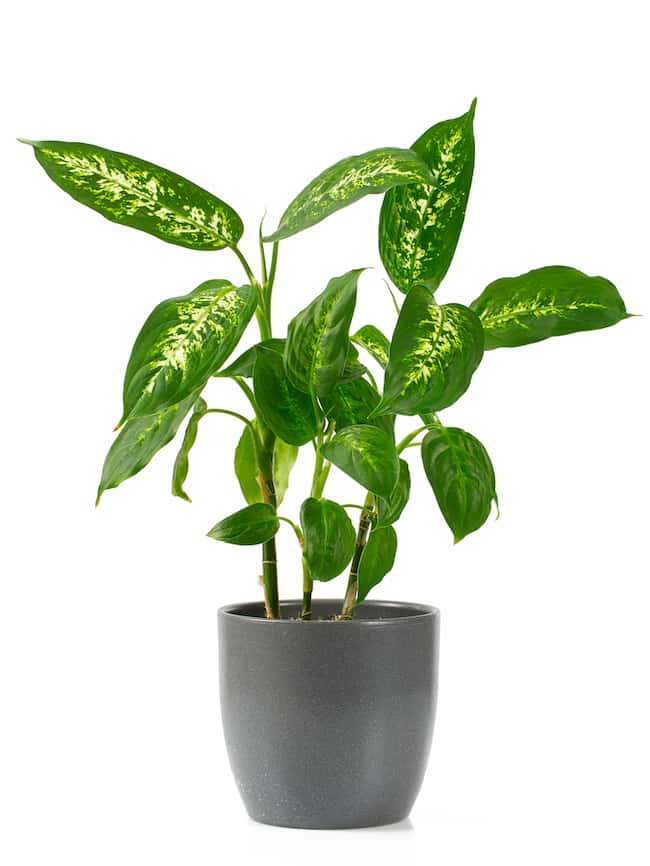
Dumb cane, Diffenbachia spp. is an herbaceous perennial in the Araceae family that can grow up to 10 feet tall, but averages three to five feet. It has large green leaves that can have cream or white patterns. It’s native to the Caribbean and South America and is highly toxic to humans and animals.
This plant needs high humidity and low to high filtered light, but should dry out somewhat between watering. Diffenbachia will do well in shady conditions but may need extra light in winter to grow best. Because of its size, dumb cane makes a nice statement plant or focus in indoor settings.
14. Hoya (Hoya carnosa)
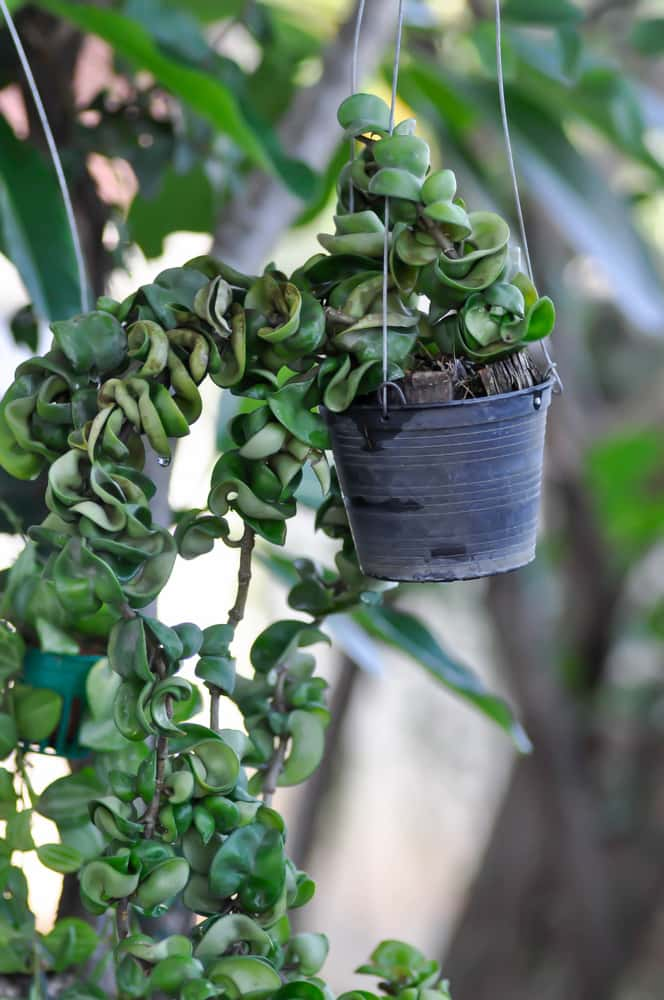
Hoya plant, Hoya carnosa, is a tropical flowering succulent native to tropical Asia and Australia. It has waxy leaves on vining stems, making it a good plant for hanging baskets. Fragrant flowers form a ball-shaped cluster and range from yellow, orange, pink, white, burgundy, or black.
Hoya plants prefer humidity and would do well near an aquarium if you have fish or near a humidifier. Although they like external humidity, they like to dry out between watering and need monthly fertilizing with a general houseplant food when they are flowering. Importantly, for your purposes, they don’t need direct sunlight so keeping this as an indoor houseplant away from a direct light source will still allow it to thrive.
15. Japanese Sago Palm (Cycas revoluta)

The Japanese sago palm, Cycas revoluta, is a tropical cycad native to Japan and southern China. Cycads grow from a trunk and produce nuts without flowers or fruit. They are very slow growing perennial shrubs with long green fronds that appear palm-like but aren’t true palms. They take several years to grow to three feet tall.
They like humidity, so use regular misting or a nearby humidifier to keep them happy. Let them dry out between watering to avoid root rot, and keep them out of direct sunlight. They don’t need much light at all to thrive although too much shade will negatively affect their growth, while this is fine as a plant that can survive without sunlight all the time, make sure they are not kept in very low light.
16. Parlor Palm (Chamaedorea elegans)
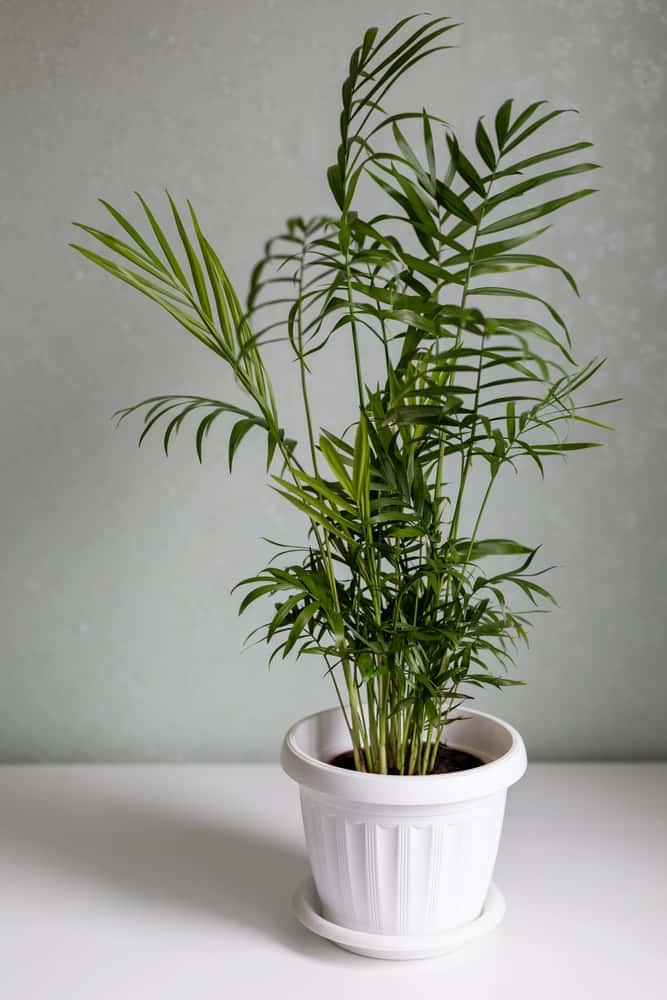
Parlor palm, Chamaedorea elelans, is a palm in the Arecaceae family that’s native to the rainforests of Guatemala and southern Mexico. It gets two to three feet tall and wide, and adds refreshing greenery to any space. As a tropical plant, parlor palm needs warmth and humidity, although it tolerates low light conditions well, along with lower temperatures.
Avoid overwatering and direct sunlight, even for brief periods, as it will burn leaves and stems. The parlor palm does well in most soil conditions, although don’t use a mix that is too spongy and holds water to avoid water logging the roots. These plants are very low maintenance and long lived if you pay attention to their basic growing needs.
17. Cast Iron Plant (Aspidistra elatior)
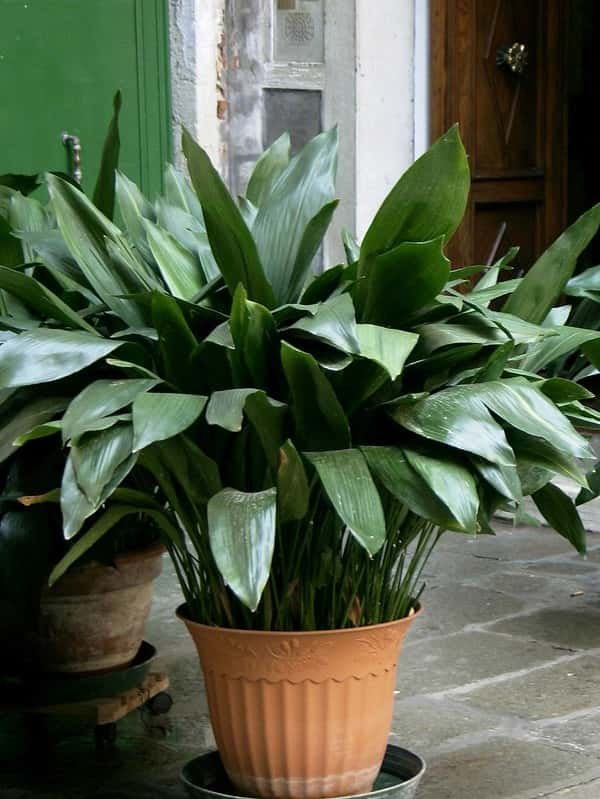
Cast iron plant, Aspidistra elatior, is a very hardy (read: super hard-to-kill) herbaceous perennial plant that survives neglect and tolerates low light conditions. It has large, arching, long green leaves that lend a tropical greenery to any space.
It’s a slow-growing plant that doesn’t like to be waterlogged, so let it dry out between watering. A cast iron plant is not susceptible to many pests and can even handle deep shade, making it an ideal plant for inexperienced houseplant growers. These plants are the ultimate no-fuss houseplants that almost anyone can grow, especially if you’re looking for great indoor plants that don’t need sun.
18. Rex begonia (Begonia rex-cultorum)
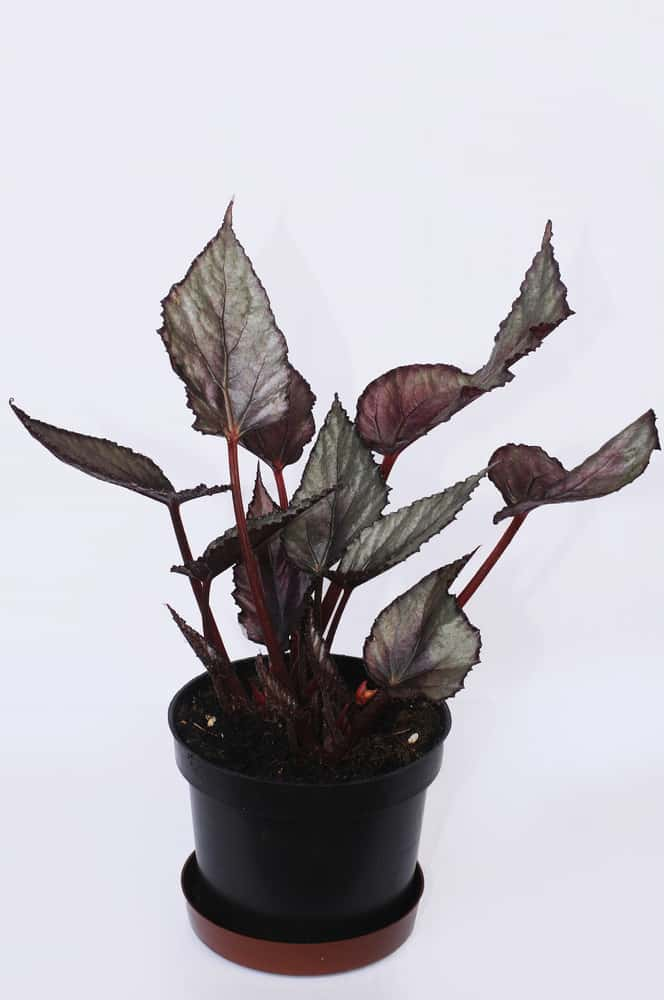
Rex begonia, Begonia rex-cultorum, is an herbaceous perennial native to eastern Asia. They have stunning large variegated leaves in various colors, including green, silver, red, and purple and can be a beautiful small plant that doesn’t need sunlight for your desk or coffee table. However, while they may look great in your house, keep in mind that they are toxic to animals, so it’s worth considering whether to get this plant if you have pets.
Rex begonia likes warmth and humidity for the best growth, but use misting sparingly to avoid powdery mildew. Don’t overwater, but don’t let the soil dry out completely either to avoid stressing the plant. Importantly, they like bright, indirect light all year and do well under artificial lighting.
19. Creeping Fig (Ficus pumila)
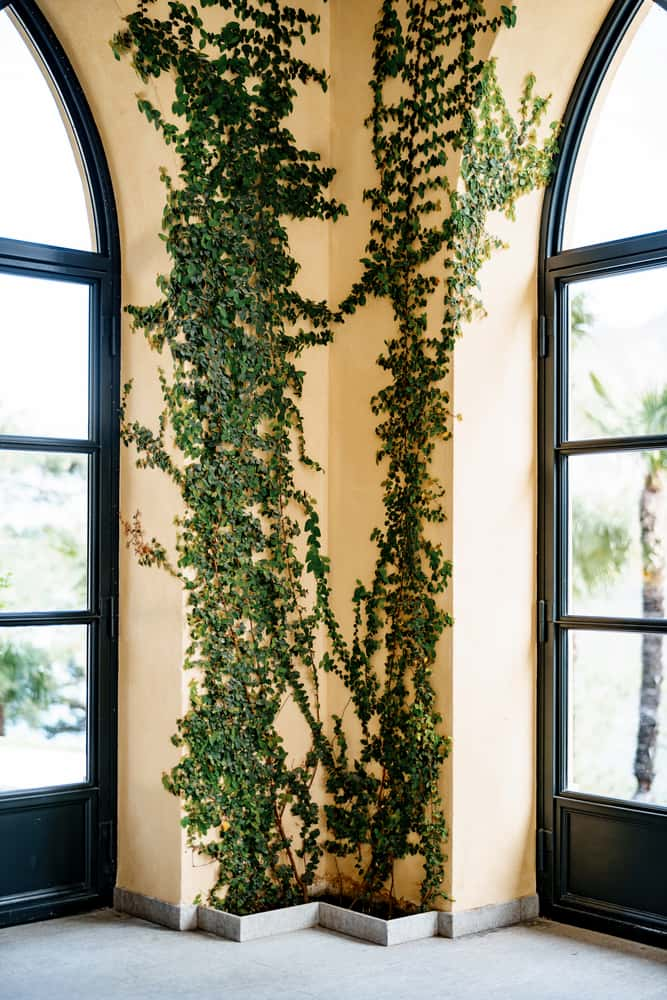
Creeping Fig, Ficus pumila, is a vining plant native to Asia that is toxic to dogs and cats. It can grow to 15 feet tall and six feet wide in ideal conditions. It makes a lovely hanging basket plant and grows beautiful vines quickly and easily, which can be controlled with trimming that it tolerates well. The effect of the hanging vines can be a great addition to brighten up a room without much light, especially if you’re not able to have any other plants that grow without sunlight there.
The creeping fig likes warmth and humidity, but won’t last more than a few years when grown in pots indoors, so it’s recommended to propagate new plants from cuttings. If grown outdoors, the creeping fig becomes invasive quickly because of its aggressive growth habit.
Can a plant stay alive without light?
All plants can stay alive without light for a short period of time. While it’s clear that this is possible temporarily, like throughout the night, this is also the case for longer periods of time in an emergency. Depending on the plant, they can survive without light for several days up to several weeks.
When the light source is cut off, the grass leaves adapt in a process called etiolation by stretching for light. Without light for photosynthesis, the leaves lose their green color. While some plants have lost the ability to process light and sustain themselves through photosynthesis, they still rely on the plants that they use parasitically which need light.
In fact, even parasitic plants that don’t need light to grow rely on other plants that do need light in order to themselves survive.
If you have plants under an artificial light, and that light source is cut off for a day, I wouldn’t stress too much as your plants should be alright. Of course, if you leave them without light indefinitely, they will suffer, getting spindly while seeking light. They will be stunted and eventually die without light.
However, if their light is restored soon enough, and all their growing conditions are met, they will recover.
How to grow plants indoors without sunlight
If you want to grow plants indoors without sunlight coming in through a window, you should find a source of artificial light. While it can help to focus on growing plants that do well in shade and low light conditions, LED grow lights can be a good substitute for natural sunlight.
While plants growing outside get their energy for photosynthesis from sunlight, artificial lights can provide the same resources for your plants inside. And in many cases, artificial light for plants that don’t need sun can be preferable to putting plants near windows for sunlight, which can burn them if too intense for too long. Artificial lights aren’t too warm, especially if placed properly far enough above plants.
In any case, to grow plants indoors, you need to pay attention to the amount of light you can provide and your plants’ growing condition needs.
That is, while some plants can grow without sunlight, most plants need at least some light for the photosynthesis that provides their food and fuel to grow and survive. In the absence of natural sunlight, like in a room with few or no windows, LED lights can help your plants grow (or, indeed, other types of grow lights). In spaces that have some light from windows but not a high level of bright sunlight for the whole day, growing plants that grow well in low-light conditions is a good option.
Dracaenas, snake plants, some orchids, and some ferns can tolerate or even prefer low-light conditions, as this is more than enough for them to power their photosynthesis process that converts water and carbon dioxide into the food plants need for energy to grow and thrive.
Just make sure these plants aren’t put somewhere where they accidentally get some direct light, such as near a window. If that happens with plants that grow in low light conditions, the direct sunlight can lead to them being burned.
Related: What’s the Difference Between LED Lights and LED Grow Lights?
Final thoughts on indoor plants that don’t need sun
While you shouldn’t expect any plants to be able to grow in total darkness, the plants mentioned here can grow and survive without direct sunlight. As you’ve seen, low natural light or low artificial lighting is enough light for plants like snake plant and dracaena to grow and add beautiful living greenery to your indoor space.
There aren’t many flowering plants that will grow in very low light conditions, but if you like orchid flowers, the moth orchid will grow in low light. In fact, most orchids do not tolerate direct sunlight, and will suffer if left in the sun with sunburn and permanent damage to their broad leaves.
In addition to the plants we discussed above, many varieties of ferns will grow in low light conditions. Their natural habitat is in the forest floor under the shade of trees and bushes. But ferns can be delicate and not as hardy and easy to grow as the more ideal low-light plants we recommend here, so while you can try to grow them, be aware that they can be a bit finicky.
Finally, you should also keep in mind that if you grow any of the plants that don’t need sunlight inside that are discussed here, it is not wise to move them outside in the summer unless they are shaded. Moving a plant that has been growing in low light outside into sunlight will shock it and sunburn its leaves and stems. It will cause permanent damage and possibly kill it.
